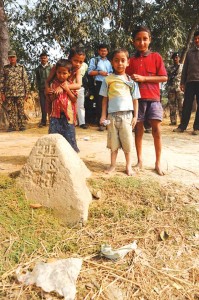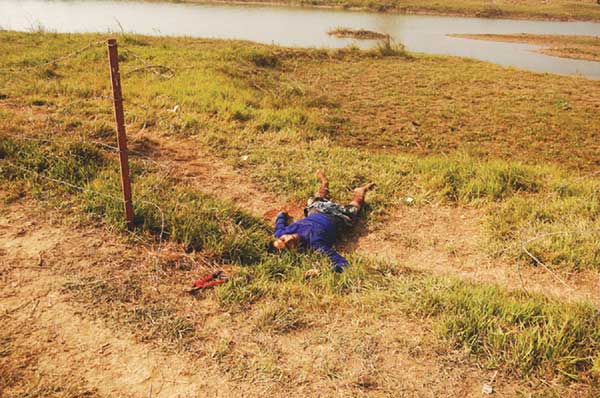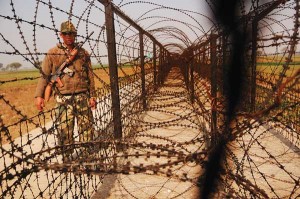Terror Trail in the East
The India-Bangladesh border is now the hub for terrorist infiltrators. After almost every recent terror attack the Government claimed that the terrorists had infiltrated into India from Bangladesh – men like Safiqul, alias Dipak, a suspected Lashkar-e-Tayebba terrorist. Safiqul used to regularly enter and leave India from Bangladesh, until he was arrested by the crime branch of the West Bengal police in Harishchandrapur in Malda last month, from the house of an ex-army driver. According to Siddhinath Gupta, DIG, CID (Operations), “…he (Safiqul) has confessed before the police that he had brought two LeT militants from Bangladesh in to J&K. Apart from that he was given the task of opening a shop in front of Siliguri cantonment and inform the Bangladeshi handler about the movement of the Army.”
I decided to trace the trail of terror along the border, and find out just how easy it is for infiltrators to enter India. I visited the stretch along the border in Malda, which Safiqul allegedly used. At the border, I found an improvised border fence, not much of a deterrent for a determined infiltrator. Sometimes I would come across small border pillars, but at the dead of the night, these pillars have little meaning or significance for border dwellers on both sides. “The infiltrators are not using any other border region as much as they use the India-Bangladesh border. This is why the BSF is very concerned about this region and has tightened the security here,” said Nilkanta Tada, BSF soldier.
BSF soldiers like Rai Singh work nearly 14 hours a day. Longer, when they are on night patrol. But despite their vigil, day after day, night after night, people make their way across this porous border. Each soldier has to guard a stretch of around 500 meters to 1 kilometer, armed with a gun and a torch. After sun down infiltrators are always waiting to make their move. “Yes they do. They watch our movements and when we cross a point or turn our back they cross over. Sometimes they also cause diversions to distract us and take advantage of the ensuing chaos…” Singh’s voice fades away as he walks into the darkness along the small patch of India’s border in the Malda sector that he was tasked to guard on the day I met him.
Further that night along with the BSF I planned a series of simulation exercises to find out for myself how infiltration happens along the Indo-Bangladesh border. The reality on the ground is astounding. Along the vast, dark, unfenced areas of the border visibility is less than 15 feet. On a cloudy night or foggy night the visibility drops to 5 feet. Consider a small nugget of information that you might have read earlier in this piece; a BSF soldier is detailed to guard a stretch of 500 meters, sometimes even 1 km stretch in some areas. In the simulation exercises where I played the role of an illegal migrant, I would be merely 15 feet away from a BSF naka point or check post, but they could not see me. But I knew, like all the human traffickers and the guides who direct illegal migrants and subversive operatives, where the BSF soldiers were positioned by monitoring their patrolling movements. So if I were an illegal migrant, or even a terrorist, I could have easily evaded the check post and made my way into India.
Night visibility along the eastern borders is a key issue. In the pitch darkness of the night it is easy for determined terrorists to sneak across to India.
The BSF’s vigil along the eastern border has been scaled up significantly. Recognizing the BSF’s operational handicaps, the government has started a modernization drive. Some units have been given these night vision devices, to enable them to see in the dark. However, even with the help of scarce night vision devices distributed across units guarding vulnerable stretches of the border, the operational difficulties in fog and darkness disables the objective of effective domination of the border.
Recently, the BSF Director General, Mahendra Kumawat, stated that on the eastern frontier fencing is 75 per cent complete with 2,859 km of the sanctioned 3, 783 km fenced. The BSF will set up 300 additional Border Observation Posts (BOPs) on the eastern frontier in the next five years. These would include floating BOPs to monitor and interdict movements on the riverine border that stretches to about 1,160 km. At present there are two F/BOPs deployed in the Ichamati River along the riverine border in the Sundarbans area of West Bengal. The BSF’s water wing is being modernized to take up the enormous challenges of coastal security in the Sundarbans.
Night visibility along the eastern borders is a key issue. In the pitch darkness of the night it is easy for determined terrorists to sneak across to India. The BSF’s vigil along the eastern border has been scaled up significantly. But even then the task of border management continues to be challenging. This border continues to remain an easy passageway for terror.
The Infiltrators
Off camera senior BSF officers admit that some corrupt soldiers do accept inducements from infiltrators. But along the eastern border, overworked and stretched thin, 45,000 troops of the BSF soldiers are still India’s unsung heroes. The three-layered fence to secure India’s eastern border hasn’t been able to deter illegal migrants and all variety of smugglers. I have video evidence of narcotics smuggling across the fence. Small consignments of narcotics are hidden in dense vegetation along the fence.
The India-Bangladesh border is now the hub for terrorist infiltrators. After almost every recent terror attack the Government claimed that the terrorists had infiltrated into India from Bangladesh – men like Safiqul, a suspected Lashkar-e-Tayebba terrorist.
A group of smugglers keep watch on border patrols and communicate with each other through mobile phones. Once an all clear signal is given, a smuggler rushes out of his hiding place, picks up a bundle and throws it over the three-layered fence, much like a expert basket ball player. Slam, dunk! The people who throw such consignments with practiced ease are called ‘throwers’ in the eastern borderland areas and, predictably, are much in demand. Soon across the fence on the Bangladeshi side, shadowy figures emerge; one of them scoots to the consignment, picks it up and vanishes into the undergrowth.
Narcotics are rampantly smuggled across the India-Bangladesh border. The three-layered fence is meant to accomplish the nettlesome task of preventing smugglers, migrants, traffickers and gun-runners from entering India from Bangladesh. As mentioned earlier, 2859 km of the 4095 km long border have been fenced with barbed wire and concrete by India, under an over Rs 600 crore rupee project. But as this author found out, migrants and infiltrators still make it across.
I met Kohinoor Asrafi, a suspected terrorist infiltrator, at the 57 Battalion HQ, BSF in the Malda sector. Interrogators from various agencies found out that he was fluent in Hindi and Bengali. He was caught by the BSF with a diary full of contacts in Pakistan, Delhi and Patna. The 2002 diary begins with the handwritten lines, ‘Ya Allah! Destroy these people’.
But Asrafi claimed innocence and said the diary was an old one and simply had personal details. I was allowed to interact with Asrafi. “A coolie demanded Rs 800 to get me across and Rs 400 for returning. I came here with the help of a dalal (human trafficker). He warned me if I tell anyone he will get me caught.”
 Others like Safia cross over in search of a better life. Safia, who lives in Jessore district in Bangladesh, claims she entered India legally from the Petrapol border crossing, to get treatment for appendicitis.
Others like Safia cross over in search of a better life. Safia, who lives in Jessore district in Bangladesh, claims she entered India legally from the Petrapol border crossing, to get treatment for appendicitis.
“Q: How much did operation cost?
A: Rs 15,000/-?
Q: How much did you bring from Bangladesh?
A: Rs. 200/-
Q: How did you get so much money?
A: I begged at Hazir Ali Dargah in Kolkata.”
Once in Kolkata, Safia decided to stay back and do household work as a domestic help. “I earned Rs 4,500 because I needed the money to cross the border.” She was caught by the BSF while trying to illegally cross back into Bangladesh with her eight year old son. Safia says she was trying to fetch her daughter from Bangladesh, but was abandoned by a trafficker when they were spotted by the BSF.
“He ran away to Bangladesh. I could not. I fell down and could not get up.
Q: How many people from your village have crossed over?
A: None from my place …from other villages.
Q: Why do people cross over?
A: Bangladesh is a poor country. We cross over to earn money.”
Over 30 years the Left Front government has allowed Bangladeshi migrants to cross over into West Bengal to bloat their vote bank.
Large stretches of the infiltration-prone region continue to be unfenced, like the border areas of Barasat, just two hours away from Kolkata, where Indians and Bangladeshis live in close proximity. “I have my relatives there. My son has been settled in Bangladesh for a long time, he has also married there. We meet either when he comes here by road or when we go to Bangladesh with our passports and visas. Lots of people here have relatives in Bangladesh,” said Mosiur Rehman Sheikh. In some stretches along the north 24 Parganas district of West Bengal, the border appears to be better guarded.
Illegal migration along this stretch is an open secret. I met an illegal Bangladeshi migrant who has acquired all necessary documentation to prove his Indian citizenship. I video-recorded his interview along with pictures of his Indian voter identity card. This is what he had to say: “There are millions of Bangladeshi migrants who have settled down in India by procuring Indian citizenship documents, primarily ration cards and voter identity cards.
There are travel agents in the Bangladeshi border towns that employ human traffickers. They have contacts with political agents in West Bengal. It’s an elaborate network. So the moment a Bangladeshi migrant crosses over he or she knows where to go, whom to meet. They establish contact with representatives of the local politicians. The local politicians in turn have another set of people who interact with the bureaucracy and the police. So it’s a well oiled machinery that facilitates the entry of illegal migrants.
Once through the right channels an illegal migrant is introduced to the local politicians and government officers and he or she has paid the requisite speed money, everything gets done. Ration card, enrolment in the voters list, followed by voters identity card, driving license, all documents to prove Indian citizenship, genuine documents, are created. This entire process takes three to six months.”
Over 30 years the Left Front government has allowed Bangladeshi migrants to cross over into West Bengal to bloat their vote bank. I met many Bangladeshis who are now Indian by documentation and all of them revealed that they have made it into the voters list, and cast their ballots in elections. Here are some more quotable quotes of illegal Bangladeshi migrants. All these quotes are on record in video taped interviews.







BSF should be called ” BANGLADESHI STRATEGIC FORCE ” They are more corrupt & venal than any police force of India..They are not only taking taking money to allow Bangladeshi infiltrators but compromising the security of India..Many Politicians of West Bengal,Tripura & other NE states along with the Civil services are deeply involved in the racket..One Temporary solution could be to Increase ex-servicemen entry into BSF, mix Army Jawans & Army officers with BSF,Give all posts of BSF intelligence to Mil.Intelligence & hand over the top officer cadre posts of BSF to Army & ex Army.. Also, Large consignments of Narcotics,Smuggled Chinese goods,Animal skins etc are being allowed entry by BSF into india from NE.
Well, I will raise a hornets nest by saying what I am saying. Smuggling of people on the BD border is an organised racket aided and abetted by the BSF. It was from the horses mouth when a BSF officer attached to my unit for training said over a couple of drinks that I am loosing 40000 a month by being there. The year was 1998. The rate is per head and its worked out by meetings with people across. If you remember there was a BSF officer killed by Bangladeshi civilians inside BD territory. It was an outrageous incident but why did the BSF and the Indian government hush it up. What was he doing across?? Negotiating the smuggling of humans. I know everyone is going to be baying for my blood and everyone is going to deny it; but it happens. My own source was caught and killed by the BSF in cold blood as they were scared he would spill the beans on them. He even told them to speak to me but he was just dragged aside and shot. Lot of the things I say cant be corroborated because there is no written record kept of issues that take place when we are fighting Insurgency. Taking reporters to the border is just an exercise in publicity but what actually happens ; we know. Smuggling of people is organised and financed by ISI aided by fundamentalist organisations in BD. It funded by Saudi money. The illegal is directed to a specific madrassa in Assam or one of the eastern states. He is then sustained by the madrassa till he finds an occupation. Bangladeshis work for a pittance to get a job undermining local labour. Just research rural Dimapur and you will get the answers. The army has been crying hoarse over the issue but the government turns a blind eye to the whole sordid mess. Just because of the muslim vote bank. There is a governors report on the demographic changes in a few districts of Assam and Kokrajhar is one of them. He was given a shut up call. He was an ex army guy.
You are absolutely right Colonel. That what you have said is the bitter truth; the harsh reality which this country would like to ignore. Bangladeshis work for a pittance as labourers almost through out the country. In Mumbai, I came across two labourers working in my building conversing in Bangla. On confronting them, they vamoosed. The Contractor defended his action stating that they worked for less than half the rate of Indian labourers. Unless stringent action is not taken, this demographic invasion will have serious repercussions for the country’s security.